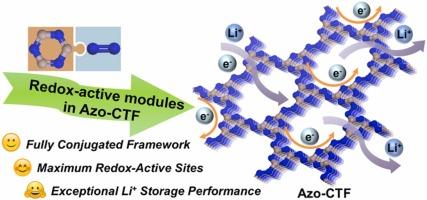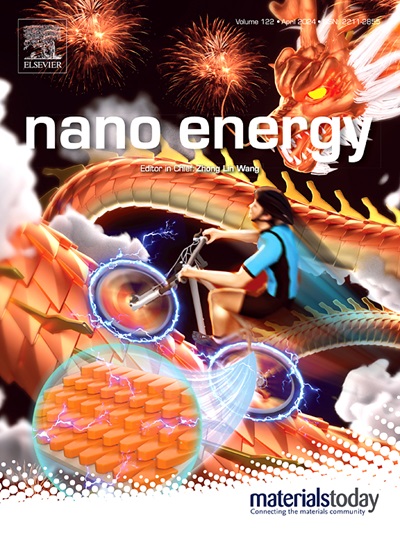Fully Extended Conjugated Azo-Bridged Covalent Triazine Framework with Maximum Dual-Redox-Active Sites for Advanced Lithium Organic Batteries
IF 16.8
1区 材料科学
Q1 CHEMISTRY, PHYSICAL
引用次数: 0
Abstract
Lithium organic batteries based on organic electrode materials (OEMs) have opened up a new way to develop high-performance and environmentally friendly energy storage devices. However, OEMs reported thus far are still severely limited by poor electrical conductivity and unsatisfactory capacity. Herein, we creatively propose to directly conjugate the active motifs with functional linkers in OEMs for simultaneously increasing conductivity and capacity. As the first attempt, an exclusive azo-bridged covalent triazine frameworks (Azo-CTF) where triazine motifs are directly linked with azo groups, is cleverly designed and constructed. By virtue of the thoroughly electron conjugation throughout azo bridges and triazine π units, Azo-CTF with the lowest energy bandgap (2.62 eV) exhibits excellent essential charge conductivity. More excitingly, Azo-CTF achieves maximum redox-active sites integration (with the mass ratio reached to 70%) to date. Therefore, Azo-CTF anode shows an almost record performance with a high reversible capacity (2332.8 mAh g-1 at 0.1 A g-1) and inspiring rate characteristics (1034.4 mAh g-1 undergoing 500 cycles at 2 A g-1, 690.2 mAh g-1 undergoing 1000 cycles at 5 A g-1). Our work provides a new strategy for synchronously improving the conductivity and capacity of OEMs, which would greatly promote the development of lithium organic batteries.

求助全文
约1分钟内获得全文
求助全文
来源期刊

Nano Energy
CHEMISTRY, PHYSICAL-NANOSCIENCE & NANOTECHNOLOGY
CiteScore
30.30
自引率
7.40%
发文量
1207
审稿时长
23 days
期刊介绍:
Nano Energy is a multidisciplinary, rapid-publication forum of original peer-reviewed contributions on the science and engineering of nanomaterials and nanodevices used in all forms of energy harvesting, conversion, storage, utilization and policy. Through its mixture of articles, reviews, communications, research news, and information on key developments, Nano Energy provides a comprehensive coverage of this exciting and dynamic field which joins nanoscience and nanotechnology with energy science. The journal is relevant to all those who are interested in nanomaterials solutions to the energy problem.
Nano Energy publishes original experimental and theoretical research on all aspects of energy-related research which utilizes nanomaterials and nanotechnology. Manuscripts of four types are considered: review articles which inform readers of the latest research and advances in energy science; rapid communications which feature exciting research breakthroughs in the field; full-length articles which report comprehensive research developments; and news and opinions which comment on topical issues or express views on the developments in related fields.
 求助内容:
求助内容: 应助结果提醒方式:
应助结果提醒方式:


